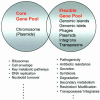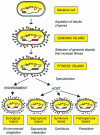Ecological fitness, genomic islands and bacterial pathogenicity. A Darwinian view of the evolution of microbes
- PMID: 11375927
- PMCID: PMC1083891
- DOI: 10.1093/embo-reports/kve097
Ecological fitness, genomic islands and bacterial pathogenicity. A Darwinian view of the evolution of microbes
Abstract
The compositions of bacterial genomes can be changed rapidly and dramatically through a variety of processes including horizontal gene transfer. This form of change is key to bacterial evolution, as it leads to 'evolution in quantum leaps'. Horizontal gene transfer entails the incorporation of genetic elements transferred from another organism-perhaps in an earlier generation-directly into the genome, where they form 'genomic islands', i.e. blocks of DNA with signatures of mobile genetic elements. Genomic islands whose functions increase bacterial fitness, either directly or indirectly, have most likely been positively selected and can be termed 'fitness islands'. Fitness islands can be divided into several subtypes: 'ecological islands' in environmental bacteria and 'saprophytic islands', 'symbiosis islands' or 'pathogenicity islands' (PAIs) in microorganisms that interact with living hosts. Here we discuss ways in which PAIs contribute to the pathogenic potency of bacteria, and the idea that genetic entities similar to genomic islands may also be present in the genomes of eukaryotes.
Figures



References
-
- Arber W. (2000) Genetic variation: molecular mechanisms and impact on microbial evolution. FEMS Microbiol. Rev., 24, 1–7. - PubMed
-
- Bach S., de Almeida, A. and Carniel, E. (2000) The Yersinia high-pathogenicity island is present in different members of the family Enterobacteriaceae. FEMS Microbiol. Lett., 183, 289–294. - PubMed
-
- Buchrieser C., Brosch, R., Bach, S., Guiyoule, A. and Carniel, E., (1998) The high pathogenicity island of Yersinia pseudotuberculosis can be inserted into any of the three chromosomal asn tRNA genes. Mol. Microbiol., 30, 965–978. - PubMed
Publication types
MeSH terms
LinkOut - more resources
Full Text Sources

